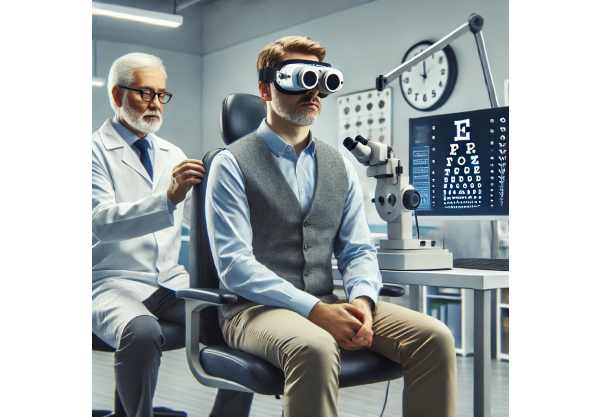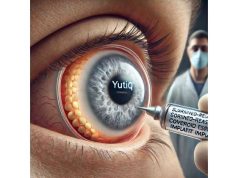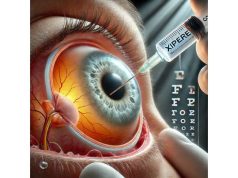
Hyperphoria is a subtle yet impactful form of binocular vision disorder where one eye tends to drift upward when binocular fusion is disrupted, but realigns when both eyes are used together. This latent vertical misalignment can cause a range of symptoms—from mild visual discomfort to significant eye strain, blurred vision, headaches, and even trouble concentrating, especially during sustained reading or computer work. In this comprehensive, evidence-based guide, we’ll explore the nuances of hyperphoria, its causes, diagnostic approach, classic and advanced management strategies, and the most promising technological and therapeutic innovations for achieving long-term visual comfort and stability.
Table of Contents
- Condition Basics and Epidemiological Patterns
- Mainstream Treatment Strategies and Pharmacological Approaches
- Surgical Procedures and Minimally Invasive Interventions
- Recent Technological Breakthroughs and Innovative Therapies
- Clinical Research Pipeline and Emerging Trends
- Frequently Asked Questions
- Disclaimer
Condition Basics and Epidemiological Patterns
Hyperphoria is defined as a latent vertical deviation of the eyes—meaning that the eyes are properly aligned under normal conditions, but when binocular (two-eye) vision is disrupted, one eye tends to drift upward relative to the other. Unlike manifest vertical deviations (hypertropia), hyperphoria remains hidden due to the eye muscles’ ability to compensate, but symptoms can arise when this compensation is overworked.
What Causes Hyperphoria?
- Minor imbalances in extraocular muscle tone
- Subtle anatomic differences in orbital structures
- Uncorrected refractive errors (especially astigmatism or anisometropia)
- After-effects of head trauma or eye muscle surgery
- Aging changes in the eye’s alignment system
Prevalence and Demographics
- Hyperphoria is less common than horizontal phorias (like exophoria), but it is not rare.
- It can appear in any age group but may be noticed more in adults who do prolonged near work or in children with significant refractive errors.
- Family history of binocular vision issues or strabismus increases risk.
Key Symptoms
- Headaches, especially with reading or computer work
- Eyestrain, fatigue, intermittent blurred or double vision (vertical diplopia)
- Difficulty with concentration, especially on detailed visual tasks
- Neck and shoulder tension due to head-tilting as compensation
- In children: avoidance of near work or complaints of visual discomfort
Pathophysiology Simplified
The brain’s visual system has a strong capacity to keep the eyes aligned, but when the natural vertical drift (phoria) exceeds what the muscles can compensate, symptoms appear—especially under visual stress or fatigue.
Everyday Impact
- Some people may go years without noticeable symptoms, while others experience daily discomfort.
- Symptoms often worsen with stress, illness, fatigue, or increased near visual demands.
Practical Advice for Early Recognition
- Take note of headaches, blurred or double vision, or fatigue that worsens with reading or screen time.
- Watch for subtle head tilting, especially in children.
- Seek a comprehensive eye exam—including binocular vision assessment—if symptoms persist.
Early detection and the right management can transform daily comfort and visual performance for those with hyperphoria.
Mainstream Treatment Strategies and Pharmacological Approaches
Managing hyperphoria starts with non-surgical, evidence-based therapies designed to relieve symptoms, improve binocular function, and support comfortable, clear vision.
Corrective Lenses
- Prism Glasses:
The cornerstone of hyperphoria management, prism lenses are incorporated into eyeglasses to shift light and help align images, reducing the workload on eye muscles and relieving symptoms. - Prescription Update:
Uncorrected refractive errors (even minor ones) can worsen hyperphoria, so a precise prescription is critical. - Bifocal or Multifocal Options:
For those with presbyopia or significant near visual strain, bifocals or progressives with built-in prism correction may be ideal.
Vision Therapy (Orthoptics)
- Eye Muscle Exercises:
Tailored therapy, often with a vision therapist, can strengthen binocular coordination and fusion reserves, enhancing the ability to compensate for latent misalignment. - Computer-Based Training:
Modern digital vision therapy programs target eye tracking, fixation stability, and fusion, with progress monitored remotely or in-office. - Pencil Push-Ups and Brock String:
At-home exercises to support binocular control, sometimes used as a supplement to office-based therapy.
Pharmacological Support
- There are currently no medications specifically for hyperphoria correction.
- In cases with significant eye strain, lubricating drops may offer temporary comfort.
- Rarely, muscle relaxants or anti-inflammatory agents may be used to manage acute symptoms from related eye or muscle inflammation.
Practical Everyday Management
- Take regular breaks during near work (the “20-20-20 rule”).
- Use good lighting and proper posture to reduce visual and neck strain.
- Teach children and adults to recognize symptoms early and seek help if comfort declines.
When to Choose Conservative Therapy
- Most cases respond well to prisms and/or vision therapy.
- Early intervention can prevent symptom escalation and secondary problems, such as chronic headaches or academic difficulties in children.
Consistent use of prescribed lenses and a proactive approach to visual hygiene can dramatically improve quality of life for those with hyperphoria.
Surgical Procedures and Minimally Invasive Interventions
Though most people with hyperphoria achieve relief with non-surgical strategies, some cases—especially those with large deviations, persistent symptoms, or failure of conservative measures—may benefit from surgical or procedural approaches.
Who Might Need Surgery?
- Patients with significant vertical deviation not manageable with prisms
- Those who develop constant vertical double vision (vertical diplopia)
- Children or adults with associated strabismus (manifest misalignment)
Key Surgical Options
- Vertical Muscle Recession/Resection:
Eye muscle surgery can weaken or strengthen specific vertical muscles (usually the superior or inferior rectus or oblique muscles) to reduce the phoria and realign the eyes. - Adjustable Suture Techniques:
Allow fine-tuning of eye position during or after surgery for optimal alignment, especially helpful in adults or complex cases. - Botulinum Toxin (Botox) Injection:
Occasionally used for temporary weakening of overactive muscles, particularly in cases where surgery is high risk or as a diagnostic tool.
Emerging Minimally Invasive Interventions
- Microincisional Strabismus Surgery:
Uses tiny incisions for less discomfort and faster recovery. - Laser-Assisted Procedures:
Early research is exploring the use of lasers for precise muscle modification, though not yet standard care.
Preparing for Surgery
- Undergo a comprehensive strabismus evaluation, sometimes including prism adaptation trials.
- Discuss realistic goals and possible outcomes with a specialized strabismus surgeon.
- Plan for recovery time—most patients return to normal activities within days, but double vision may temporarily increase as the brain adjusts.
Postoperative Tips
- Follow all post-surgical instructions, including eye drops and activity limits.
- Report persistent double vision, pain, or redness immediately.
- Continue with vision therapy as recommended for long-term stability.
Surgical intervention offers hope for those who don’t find relief with traditional treatments, restoring comfort and alignment for daily tasks.
Recent Technological Breakthroughs and Innovative Therapies
The landscape of hyperphoria management is evolving with the integration of technology, personalized therapy, and advanced diagnostics. Here’s what’s shaping the future:
Advanced Diagnostic Tools
- Digital Phoropters and Automated Refraction:
Provide precise measurement of vertical phorias, helping tailor prism prescriptions to each patient’s needs. - 3D Eye Tracking and Virtual Reality Testing:
Offer dynamic assessment of binocular function and alignment under real-world conditions, allowing for highly customized interventions.
Innovations in Vision Therapy
- App-Based Training:
Home-based digital platforms offer engaging, interactive eye exercises with real-time progress tracking and therapist oversight. - AI-Driven Therapy Customization:
Artificial intelligence can optimize therapy plans based on individual performance and response, enhancing outcomes.
Smart Eyewear and Adaptive Optics
- Electrochromic Glasses:
Automatically adjust lens tint and focus, reducing eye strain in variable lighting or when focusing at different distances. - Wearable Devices:
Glasses or headsets that provide live visual feedback and cueing to support proper alignment during tasks.
Neurostimulation and Novel Approaches
- Transcranial Magnetic Stimulation (TMS):
Research is exploring whether non-invasive brain stimulation can improve binocular control or reduce visual discomfort, though still experimental. - Gene Therapy:
In rare cases of genetically linked muscle imbalances, gene-editing techniques are under investigation for long-term correction.
Practical Advice for Early Adopters
- Ask your eye care provider about the latest in diagnostics and therapy, especially if symptoms persist with standard care.
- Be open to blending classic and digital approaches for best results.
These breakthroughs promise more precise, engaging, and lasting relief for people living with hyperphoria.
Clinical Research Pipeline and Emerging Trends
Ongoing research continues to shape the future of hyperphoria management, with a focus on understanding causes, optimizing therapies, and improving quality of life for patients of all ages.
Current and Upcoming Clinical Trials
- Next-Generation Prism Lenses:
Investigating lighter, thinner, and more adaptive materials for all-day comfort. - AI-Guided Vision Therapy Trials:
Comparing the effectiveness of traditional versus AI-customized home therapy programs. - Minimally Invasive Surgery Studies:
Assessing outcomes, safety, and patient satisfaction with microincisional and laser-assisted approaches. - Genetic and Biomarker Studies:
Exploring the molecular basis of eye muscle imbalances to identify those at greatest risk for vertical phorias.
Major Areas of Research Interest
- Preventing Progression:
Can early detection and vision therapy prevent mild hyperphoria from becoming symptomatic? - Digital Health Integration:
How can telemedicine and remote monitoring make therapy more accessible? - Pediatric Outcomes:
Which interventions provide lasting benefits for children, and how can early intervention support learning and development?
Looking Forward
- Greater personalization of therapy based on genetic and biometric data
- Wider use of wearable tech for continuous support and feedback
- Ongoing collaborations between optometrists, ophthalmologists, and technology companies to innovate patient care
Patient Engagement
- Ask about research studies or patient registries if you are interested in contributing to the future of care.
- Stay connected with support groups and advocacy organizations for updates on new trials and therapies.
Exciting developments ahead promise to make managing hyperphoria even more effective, accessible, and individualized.
Frequently Asked Questions
What is hyperphoria and how is it different from hypertropia?
Hyperphoria is a latent (hidden) upward drift of one eye, noticeable only when both eyes are not working together. Hypertropia is a constant, visible misalignment of one eye upward, present all the time.
What are the best treatments for hyperphoria?
Most cases respond well to prism glasses and vision therapy, which help the eyes work together and relieve symptoms like headaches or double vision. Surgery is reserved for severe or persistent cases.
Can hyperphoria go away on its own?
Mild cases may remain asymptomatic or improve with lifestyle changes, but persistent or bothersome symptoms usually require treatment for relief and to avoid complications.
How is hyperphoria diagnosed?
A comprehensive eye exam with binocular vision testing—including cover tests and measurement of phorias—can diagnose hyperphoria. Digital and 3D testing tools are increasingly available for precise assessment.
Is vision therapy effective for hyperphoria?
Yes, tailored vision therapy can strengthen eye coordination and fusion, often reducing or eliminating symptoms over time—especially when combined with appropriate lenses.
When should surgery be considered for hyperphoria?
Surgery is considered only for patients who don’t improve with conservative measures, have large deviations, or experience constant vertical double vision. Evaluation by a strabismus specialist is necessary.
Are there new advances in treating hyperphoria?
Recent advances include AI-powered vision therapy, smart prism lenses, and wearable devices that provide real-time feedback. Ask your eye care provider about emerging technologies.
Disclaimer
This article is intended for informational purposes only and should not be considered medical advice. Always consult with your eye care provider regarding any symptoms or questions about hyperphoria or vision problems.
If you found this guide helpful, please share it on Facebook, X (formerly Twitter), or your favorite platform. Your support enables us to keep producing accessible, high-quality vision health resources. Follow us for more updates—thank you for helping others on their journey to clear and comfortable vision!










